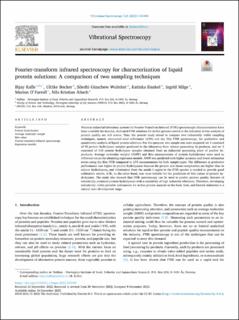| dc.contributor.author | Kafle, Bijay | |
| dc.contributor.author | Böcker, Ulrike | |
| dc.contributor.author | Wubshet, Sileshi Gizachew | |
| dc.contributor.author | Dankel, Elin Katinka | |
| dc.contributor.author | Måge, Ingrid | |
| dc.contributor.author | O'Farrell, Marion | |
| dc.contributor.author | Afseth, Nils Kristian | |
| dc.date.accessioned | 2023-04-21T12:11:11Z | |
| dc.date.available | 2023-04-21T12:11:11Z | |
| dc.date.created | 2023-03-17T09:24:25Z | |
| dc.date.issued | 2023 | |
| dc.identifier.citation | Vibrational Spectroscopy. 2023, 124, 103490. | en_US |
| dc.identifier.issn | 0924-2031 | |
| dc.identifier.uri | https://hdl.handle.net/11250/3064271 | |
| dc.description.abstract | Whereas industrial laboratory systems for Fourier-Transform Infrared (FTIR) spectroscopic characterization have been available for decades, dedicated FTIR solutions for in-line process control or for industrial at-line analysis of protein quality are still scarce. Thus, the present study aimed to compare two industrially viable sampling techniques, namely attenuated total reflectance (ATR) and dry film FTIR spectroscopy, for qualitative and quantitative analysis of liquid protein solutions. For this purpose, two sample sets were acquired: set 1 consisted of 95 protein hydrolysate samples produced in the laboratory from salmon processing by-products, and set 2 consisted of 133 protein hydrolysate samples obtained from an industrial processing plant of poultry by-products. Average molecular weights (AMW) and Brix measurements of protein hydrolysates were used as reference values for obtaining regression models. AMW was predicted with higher accuracy and lower estimation errors using dry film FTIR compared to ATR measurements for both sample types. The difference in predictive performance was higher in poultry hydrolysates because the protein and tissue complexities are higher than in salmon hydrolysates, and information from the amide I region in the FTIR spectra is needed to provide good calibration results. ATR, on the other hand, was more reliable for the prediction of Brix values of protein hydrolysates. The study also showed that FTIR spectroscopy can be used to predict protein quality features of industrially produced protein hydrolysates with a sensitivity of high industrial relevance. Therefore, developing industrially viable portable instruments for at-line process analysis in the food, feed, and biotech industries is a natural next development stage. | en_US |
| dc.language.iso | eng | en_US |
| dc.publisher | Elsevier | en_US |
| dc.rights | Navngivelse 4.0 Internasjonal | * |
| dc.rights.uri | http://creativecommons.org/licenses/by/4.0/deed.no | * |
| dc.title | Fourier-transform infrared spectroscopy for characterization of liquid protein solutions: A comparison of two sampling techniques | en_US |
| dc.type | Peer reviewed | en_US |
| dc.type | Journal article | en_US |
| dc.description.version | publishedVersion | en_US |
| dc.rights.holder | © 2022 The Author(s) | en_US |
| dc.source.volume | 124 | en_US |
| dc.source.journal | Vibrational Spectroscopy | en_US |
| dc.identifier.doi | 10.1016/j.vibspec.2022.103490 | |
| dc.identifier.cristin | 2134641 | |
| dc.source.articlenumber | 103490 | en_US |
| cristin.ispublished | true | |
| cristin.fulltext | original | |
| cristin.qualitycode | 1 | |

